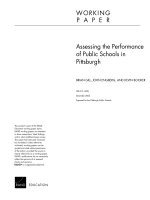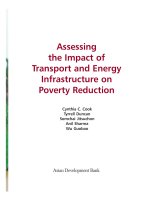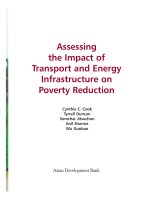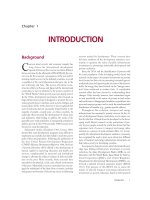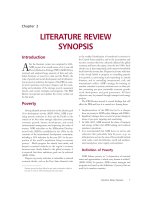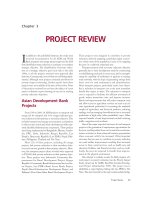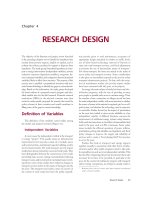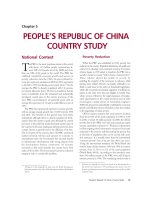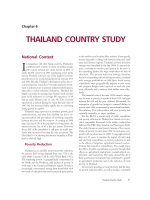Assessing the correlation of the water environmental quality and the growing ability of the water hyacinth
Bạn đang xem bản rút gọn của tài liệu. Xem và tải ngay bản đầy đủ của tài liệu tại đây (680.83 KB, 9 trang )
Le Thi Dao
Assessing the correlation of the water environmental quality...
ASSESSING THE CORRELATION OF THE WATER
ENVIRONMENTAL QUALITY AND THE GROWING ABILITY
OF THE WATER HYACINTH
Le Thi Dao1
Thu Dau Mot University
1
ARTICLE INFO
Article history:
Received Dec. 17.2018, Accepted Jan. 30.2019.
Contact:
Abstract
The results of the analysis and evaluation of the growth and development of water hyacinth in
experimental locations by the ecological fixation method of vegetable development in Sai Gon river
basin - Thu Dau Mot, Binh Duong showed that after 84 days of experiment, the water hyacinth in
different locations had the growth of stem, roots, leaves and buds. However, this growth at other
locations is different. Statistical results also showed that the water quality indexes of BOD5, COD,
total nitrogen, total phosphorus were highly correlated with the increase in the raw weight of the
hyacinth. In which total nitrogen, total phosphorus is the largest correlation.
Keywords: plant growth, surface water pollution, Water hyacinth, water quality indicators
INTRODUCTION
Water hyacinth is a very common aquatic plant in our country, which can adapt to many different
types of water sections such as canals, ditches, ponds, lakes, rivers, etc... (Pham Hoang Ho, 2000). In
some areas, water hyacinth is very useful because they are exploited as raw materials for the production
of handicrafts, food of animals (Nguyen Dang Khoi & Nguyen Huu Chiem, 1985) , or for the treatment
of wastewater (Nguyen Xuan Hoang & Le Hoàng Viet, 2004), biogas digesters, However, in other areas
, hyacinth is considered as a dangerous exotic species, because they grow very quickly when they are in
favorable condition, they rapidly spread over the surface of the water causing the traffic jam in the river
and threatening the life of other aquatic species. Over the past years, the appearance of hyacinths on the
canals of the Saigon river basin, which flows through Thu Dau Mot, Binh Duong, has become
increasingly dense. One of the main reasons for the rapid development of water hyacinths is the fact that
the water in Saigon River is seriously polluted by industrial, agricultural and domestic wastes. The paper
studies on the correlation between water quality and the development of hyacinth helping to predict the
outbreak of hyacinth through water quality indexes.
METHOD OF STUDYING
Method of ecological experiment layout
Hyacinth used for experimentation: Hyacinths are harvested from different water places
around the study site such as rivers, ponds, ditches, and then raised in the same watershed. Selecting
26
Thu Dau Mot University Journal of Science
Issue 1(40)-2019
the hyacinths has similar weight, stem length, root length, and number of leaves for the
experimentation.
Experiment layout: Three frames are put on each survey site. They are three square metres
each by using bamboo to fix the cells and using the net to surround around this the selected
location. The experiment was arranged as follow:
Figure 1. Experiment
layout to feed the
water hyacinths
Table 1. Experimental locations and Coordinates
Location (LC)
LC1
LC2
LC3
11°1'4"N
11°1'1"N
11°2'19"N
Coordinate
106°37'3"E
106°35'56"E
1 06°36'15"E
LC1: There are no waste sources around; LC2: There are some fishing ponds; LC3: There are some pig
farms with a wastewater ditch draining into the river
Weighing the fresh weight of hyacinth (W1). Measuring the length of the stem and root.
Counting the number of shoots, number of leaves, and then putting 10 trees in each plot. The
selected hyacinths should be approximately the same length (27-28 cm), root length (18-19 cm)
(Xie & Yu, 2003), weight (169-172 g), leaf number (4 leaves).
Measuring the growth parameters of the hyacinth (fresh weight, stem length, root length,
number of shoots and leaf ) every one time per two weeks (Nguyen Thi Thu Thuy, 1988). The water
hyacinths are measured within 84 days (Tran Si Nam, Nguyen Vo Chau Ngan, & Nguyen Phuong
Chi, 2014), (Huynh Thanh Tuan, 2013).
Sampling and analysis methods
Samples were taken every one time per two weeks at three locations with coordinates as arranged
experiment. At each cross section, taking water samples at depths of 50 cm and 100 cm underwater by
using a horizontal sampling device (Wildco, USA). Sampling and preservation methods comply with the
current Vietnamese Standards TCVN 6663-6: 2008 (Sampling) and TCVN 6663-3: 2008 (preservation
of samples) (Holst, Rees & Wilson, 2005), (Haller, Sutton &William, 1972).
Table 2. Methods of analysis of water quality Indexes at Thu Dau Mot University Laboratory.
Number
Index / Unit
Method
1
DO/ mg/l
Electrochemistry
2
COD/ mg/l
Closed Return - Photometry
3
BOD5/ mg/l
Keep at 200C, Measuring DO0 and DO5
27
Le Thi Dao
Number
Assessing the correlation of the water environmental quality...
Index / Unit
Method
4
Total phosphorus/
mg/l
Decomposing the sample by persulfate method and then
determining the ortho-phosphate by ascorbic acid method.
5
Total nitrogen/ mg/l
Decomposing the sample by persulfate method and then
transforming all nitrogen compound in the sample to nitrate then
determining by the OPP method.
Method of Calculating and Data Processing
Data of the analysis indexes were processed by descriptive statistics and checked correlation
with fresh weight of hybrids by regression statistic model.
RESULTS AND DISCUSSION
Development of water quality indexes
pH: At each experimental location, the pH value was measured twice per month. Taking
three values for one time. Calculating the average value (6 samples) in each month at three test
locations with the following results:
6,8
6,7
Figure 2. Development of pH
6,6
value (monthly average) at
6,5
three experimental locations
6,4
H 6,3
p
6,2
6,1
6
5,9
5,8
month
Second
month
The results showed that the pH value range fromThe
6.1First
to 6.7
at all three text
locations,
which
1 hyacinth. 6,4
6,6 for the
were suitable for the development of the LC
water
The appropriate value range
2
6,1
6,3
development of hyacinth is 6-8 (Wilson et al.,LC
2005).
LC 3
6,2
6,4 analyzes
COD: The sampling frequency for COD,
BOD, total phosphorus
and total nitrogen
at three test locations was done similar to the pH sampling.
Figure 3. Development of COD
value ( monthly average ) at three
experimental locations
28
Th
Thu Dau Mot University Journal of Science
Issue 1(40)-2019
Analysis Results showed that the highest COD value at the third location was 48 mg / L. The
COD value at the other two positons range from 50 mg / L to 40 mg / L. The COD concentration is
quite high compared to QCVN 08: 2008 / BTNMT (between B1 and B2 columns)
BOD
Figure 4. Development of BOD value ( monthly average ) at three experimental locations
Total Phosphorus (mg/L)
The Results of the analysis showed that the BOD value at three study locations were stable.
There was no significant difference between months. The highest BOD level is at the third location
was 38 mg /L. For the other two locations, the BOD value range from 25 mg /L to 34 mg /L.
Total phosphorus
The results showed that the highest concentration of phosphorus at the third position was 0.6
mg / L due to this place was passed through to the fish ponds for changing water or supplying
water in it. The other locations have a total phosphorus concentration range from 0.3 mg / L to 0.5
mg / L. In general, the phosphorus level stayed on the limit of column B2 (0.5 mg / L). However,
some values at the third location are higher than 0.1 mg / L.
0,7
0,6
0,5
0,4
0,3
0,2
0,1
0,0
LC 1
LC 2
LC 3
The First month
Second month
Third month
0,4
0,4
0,5
0,4
0,5
0,6
0,3
0,5
0,6
Figure 5. Development of Total phosphorus value ( monthly average ) at three experimental positions
29
Le Thi Dao
Assessing the correlation of the water environmental quality...
Total nitrogen
Figure 6. Development of Total Nitrogen value ( monthly average )
at three experimental locations.
The results showed that the total nitrogen concentration in each study location was quite
stable. However, there is a big difference in the research positions. The values ranged from 2.4 to
8.1 mg / L. The lowest total nitrogen concentration was at the first location (2.4 mg / L) and highest
at the third location (8.6 mg / L). This is interpreted that the water environment in the first location
is often disturbed by traffic vehicles on the river and there is also no secondary discharge source. At
the third location have a high nitrogen value due to there is a waste from the pig farm. However,
this value is still in the limits of QCVN 08: 2008 / BTNMT (column B1).
The growth of hyacinth in the experimental locations
Growth of the body length
At the beginning of the experiment, the length of the hyacinth was about 27.5-28cm. At the
end of the tests, the length of the hyacinth was increased. In particular, hyacinth in the first location
has the largest body length (37.5cm), the smallest was in the second location (34.9cm), and the
third position was 35.5cm.
Figure 7. Development of the body length over time at three experimental locations.
30
Thu Dau Mot University Journal of Science
Issue 1(40)-2019
The picture shows that the hyacinth in the first position grew fast on the length of the stem
because of its high intensity of light, so the tree tends to grow in length. The fastest body length of
the hyacinth grows in the first 14 days, the average increase from 1.8-2cm, the highest increase in
the first position and the least increase in the second location. After this period the body length
grow slowly and stably.
The root length (cm)
Growth of root length
27
26
25
24
23
22
21
20
19
18
17
LC1
LC2
LC3
The first
day
The
fourteent
h day
The
twentyeighth
day
The fortysecond
day
The fiftysixth day
18,5
18,2
18
21,3
21,5
21,1
21,7
22
21,6
22,2
23
24
22,8
23,7
24,3
The
The
seventiet
eightyh day
fourth day
23,2
24,4
24,8
24,1
25
26,2
Figure 8. Development of the root length over time at three experimental locations.
The root length of the hyacinths at the beginning of the experiment was relatively uniform
around 18 and 18.1 cm. After 84 study days, the root length of the hyacinth was the highest at the
third location (26.2 cm), the lowest at the first location was 24.1 cm. Results of the study also
showed that in the first 14 days of experiment the root length increased steadily, from the next day
the root length at the third location increased significantly, the other two locations grew slowly.
Because in the first location has a disturbance frequently, so when the tide changes, the roots in the
bottom will be hurt causing the damage. On the other hand, there is no secondary source of waste at
this location so that affects the growth of the hyacinth . According to Nguyen Dang Khoi (1985),
roots contribute 20 ÷ 50% of total weight depending on the nutritive environment. So the growth of
the root greatly influences the weight of the hyacinth.
Growth of the shoot hyacinth numbers.
The results showed that after 84 days, the shoot hyacinth at the third location was one of the
highest numbers (12 shoots), 4 shoots compared to the first location (8 buds) and 2 shoots compared
to the second location (10 buds). During the first 14 study days the number of the shoot hyacinth
only increased from 1 to 2 shoots. That is explained due to in the first days, hyacinths need time to
adapt and grow. After adapting to the environment, the water hyacinth grows and the number of
shoots increases more quickly. In addition, the open area and nutrition of the habitat is related to the
increasing of the shoot numbers.
31
Le Thi Dao
Assessing the correlation of the water environmental quality...
Figure 9. Development of the shoot numbers over time at three experimental locations
Growth of the leaf hyacinth.
Figure 10. Development of the leaf numbers over time at three experimental locations
Initially, the number of the leaf hyacinth was chosen equally (4 leaves). After 84 days, the
number of leaf hyacinth was increased many times compared to the beginning of the experiment.
The average numbers of leaf hyacinth at the third location was 60 (highest), 42 leaves at the first
location, and 53 leaves at the second location. The results showed that the number of leaf hyacinth
in the first 14 days increased slowly, but after that period the its number increased rapidly,
especially at the second location 2 and the third location. It can be said that the increase of leaves
depends entirely on the increase of shoots and it depend on the nutrient of the habitats.
Growth of the raw hyacinth weight.
At the beginning, the fresh weight of the hyacinth at positions 1, 2, and 3 were 115g, 116g,
116g in turn. During the first 14 days of the experimentation, hyacinths started adapting and
growing well. The fresh weight of hyacinths on the fourteenth day at locations 1, 2,and 3 were
150g, 157g and 160g in turn. The results showed that the fresh weight of the hyacinth in all
locations tended to increase in the next periods. At the end of the experiment, the fresh weight of
32
Thu Dau Mot University Journal of Science
Issue 1(40)-2019
water hyacinth in the third location was 765g, The growth increases 1.39 times over the first
location and 1.1 times over the second location. They grow fast and the raw weigh at the third
location is the highest because of the pig farm near there while at the first position the hyacinths
grows slowly due to there is low nutrient such as nitrogen and phosphorus.
Figure 10. Development of the raw weight hyacinth over time at three experimental locations
The correlation between the increase of the hyacinth weight and the environmental
factors.
Table 3. The correlation between the hyacinth weight and the environmental factors.
LC1
435.0
32.0
26.4
0.4
2.5
Increasing weight (g)
CODa
BOD5a
Total phosphorus (Pa)
Total nitrogen (Na)
LC2
574.0
40.0
32.3
0.5
6.6
LC3
649.0
46.3
37.0
0.6
8.4
Note: Average is abbreviated “a”
Table 4. Regression model of the correlation between the hyacinth weight and the environmental
factors at three test locations.
Factors
Regression model
CODa
RW = 15.071* COD – 41.648 (2)
BOD5a
RW = 20.33* BOD5 – 95.85 (3)
Total phosphorus (Pa)
RW = 1070* Ptb + 17.667 (4)
Total nitrogen (Na)
RW = 35.864* Ntb + 343.46 (5)
Note: Row weight is abbreviated “RW”
The growth of water hyacinth depends on environmental factors such as pH, BOD5, COD, total
nitrogen, total phosphorus. Each factor affects the growth of the hyacinth in different directions.
Statistical results showed that COD, BOD5, total nitrogen, and total phosphorus (BOD5), total
phosphorus were strongly correlated with the increasing of raw hyacinth weight (0.9
Le Thi Dao
Assessing the correlation of the water environmental quality...
CONCLUSION
After three months of experiment, all parts of the hyacinth body such as roots, shoots and
leaves have grown. The raw weight growth of hyacinths was linear with the environmental factors
are COD, BOD, Total Nitrogen, Total Phosphorus.
The growth of hyacinth was the best at the third location and was the worst at the first
location due to there is a waste water from the pig farm nearby and also less boat crossings at the
third location so that do not disperse nutrients or affect the roots.
Statistical results showed that the COD, BOD, total nitrogen and total phosphorus values
were highly correlated with the growth of the raw hyacinth weight.
The growth of the shoot numbers at the third location was 1.5 times compared to the first
location and 1.4 times compared to the second location.
At present, that the hyacinths grow fast is a problem of traffic jam on the Saigon River. It also
threatens to the lives of other aquatic species that lead to an ecological imbalance. So we need to
control of secondary sources. We are also particular about nutrient-rich sources such as nitrogen,
phosphorus, and BOD that cause eutrophication. On the other hand, it is necessary to clean the
surface of water in the river to reduce the rapid growth of the hyacinth.
REFERENCES
Haller D.L., Sutton, &William,T. (1972). Effect of pH and high phosphorous on growth of
waterhyacinth. Freshwater Biology, 55(2), 282–298.
Holst, N., Rees, M., & Wilson, J.R. (2005). Determinants and patterns of population growth in
water hyacinth, Aquatic Botany. Journal of Environmental Protection, 81, 51 –67.
Huynh Thanh Tuan (2013). Investigation of the growth of hyacinth in different watersheds in My
Khanh commune, Phong Dien district, Can Tho city (Graduate thesis). Can Tho University.
Nguyen Đang Khoi & Nguyen Huu Chiem (1985). Study on the food for animals. Hanoi:
Agriculture Publisher.
Nguyen Thi Thu Thuy (1988). Determine the initial biomass of the water hyacinth and the ability to
use water hyacinth as a feedstock for biogas (Graduate thesis). Can Tho university.
Nguyen Xuan Hoang & Le Hoang Viet (2004). Study on the treatment of wastewater by water
hyacinth. Journal of Scientific Research of Can Tho University.
Pham Hoang Ho (2000). Vietnamese Grass, Volume III. Young Publisher of Ho Chi Minh City.
TCVN 6663-3: 2008, Iso 5667-3: 2003. Water quality – sampling, Ha Noi (2008).
Tran Si Nam, Nguyen Vo Chau Ngan, & Nguyen Phuong Chi (2014). Study on the growth of
hyacinth in different watersheds. Journal of An Giang University.
Xie, Y. & Yu, D. (2003). The significance of lateral roots in phosphorus (P) acquisition of water
hyacinth (Eichhornia crassipes), Aquatic Botany 75(4), 311–321.
34

